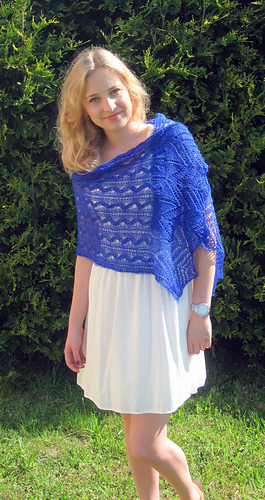patterns >  Yellow Mleczyk's Ravelry Store
Yellow Mleczyk's Ravelry Store
> Party Line

















Party Line
The shawl uses very basic lace stitches – increasing, decreasing and yarnovers. The pattern is written for both right and wrong sides and this may require more concentration at first, until you learn the pattern by heart and follow it easily.
On the other hand, it is challenging and fun to knit as there are no ‘autopilot’ parts like purling the wrong side.
The pattern can be customized by using different yarns, needle sizes, or adding repeats. There are also two versions of the edging, one shorter and the other one longer.
You can use any yarn ranging from lace to DK in solid or semi-solid colours. I used 103gr of light fingering wool, 500m/550 yards in 100g on US 2 1/2 (3,0mm) needles.
The needle size should be adapted to the yarn you use and the lacy effect you want to achieve. I have a tendency to knit loosely, especially when I knit lace, so you may opt to upsize the needle size more than you would normally do and thus obtain this additional lacy effect.
Gauge is not crucial and depends on the yarn and the needles that you choose to knit with. Still, you may want to knit a gauge following the body pattern, block it and see if the lace is ‘open’ enough for your preferences or if you need to upsize your needles.
Size – the shawl in the picture is 180 cm x 60 cm (71” x 24”) with 5 / 18 repeats of the body pattern.
Supplies - Stitch markers – their number depending on the number of repeats of the pattern (which is entirely of your choice), tapestry needle to weave in yarn ends, rustproof pins and blocking wires for blocking. Blocking needles are a must to obtain the lacy chain on longer sides.
The pattern was tested and tech-edited by English speaking knitters.
I wish you happy knitting and a beautiful final result!!!
~~~~~~~~~~~~~~~~~~~~~~~
Party Line to jeden z bardziej wymagających szali. Wzór jest wyrabiany po obu stronach robótki, na początku może się to wydawać trudne lecz po paru powtórzeniach i nabraniu wprawy dzierganie staje się dużą przyjemnością.
Włóczka - najlepiej dość cienka, włókna naturalne.
Szal wymaga blokowania!
13728 projects
stashed
17082 times
1767 projects
stashed
683 times
178 projects
stashed
227 times
14471 projects
stashed
10920 times
- First published: June 2015
- Page created: June 22, 2015
- Last updated: December 31, 2024 …
- visits in the last 24 hours
- visitors right now





